New flexibility for city's old underground spine
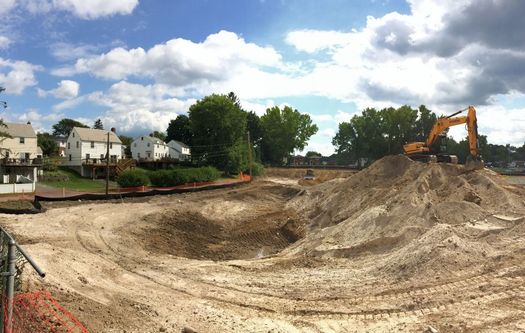
This will eventually be a pond and wetland area.
Back on August 5, 2014, the skies dumped almost three inches of rain on the city of Albany in the span of about an hour.
Parts of the city's storm sewer system just couldn't keep up with the deluge -- and there was flash flooding in many spots. People floating in inner tubes downtown. Spouting manhole covers and more than two feet of water on Elberon Place. And a little farther uptown in a section just off South Main Ave, the backyards and basements of houses were swamped with four feet of water.
Prompted in part by that day, Albany's water department is now building a $1.9 million project aimed at adding some modern flexibility to the very old infrastructure that runs up the city's spine.
What's the problem?
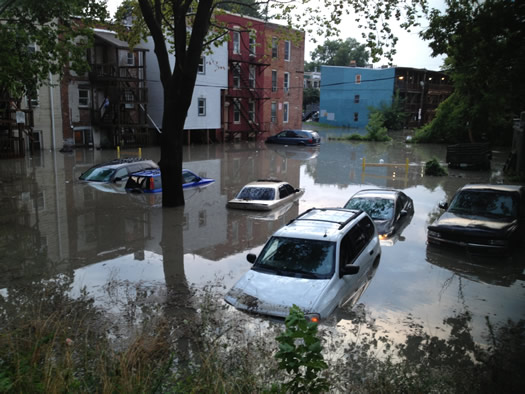
Flooding near Western and Quail in that 2014 storm. / photo via Laura (thank you, again)
In short: When the city of Albany gets a lot of rain in a short amount of time, its storm sewers can't handle the rush of water. That results in two big problems:
+ There's flooding because the system can't drain the water fast enough. You've probably seen it -- every few years a big rainfall event causes flooding at spots around the city. A few prominent examples: That storm in 2014 mentioned above, and another one in 2008.
+ Sewage ends up in the Hudson River. Albany -- like many other old cities -- has what's called a combined sewer system. The sanitary sewers and storm water sewers are connected. And when the system is overwhelmed by a deluge of rain, it overflows into the Hudson, dumping raw sewage into the river. Yep, it's gross. And it's a health and environmental problem. (These events are called "combined sewer overflows" and there's currently a big effort among the "Albany pool" communities along the Hudson River to address the issue.)
Any one of these flooding events would be a problem. But for whatever reason -- whether it's climate change or some sort of other weather cycle -- they seem to be happening more often.
As Joe Coffey, Albany's water commissioner said to us Wednesday of these large bursts of rainfall, "We've probably seen more of those in the last 10-15 years than we saw in the 50 years before that."
The long history
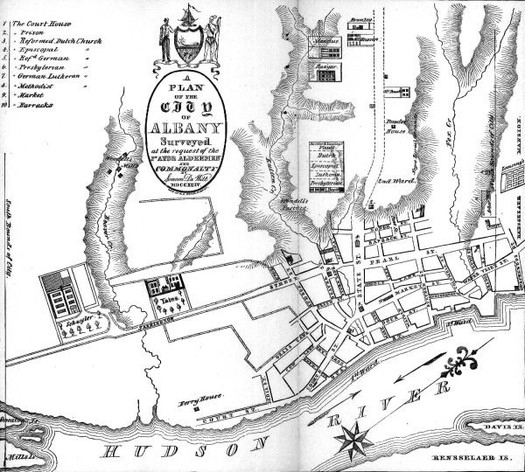
Simeon' DeWitt's 1790 map of Albany. The Beaver Kill is the stream farthest to the left on the map.
Albany is, of course, a very old place, with history layered atop of history, layered atop of history. In this situation, it's in some ways a case of that history resurfacing.
There were once three major streams that ran across what's now the city of Albany. But as the city developed and spread to the west, these streams were piped and sent underground. Along the way development consumed wetland and other space that once soaked up rainfall.
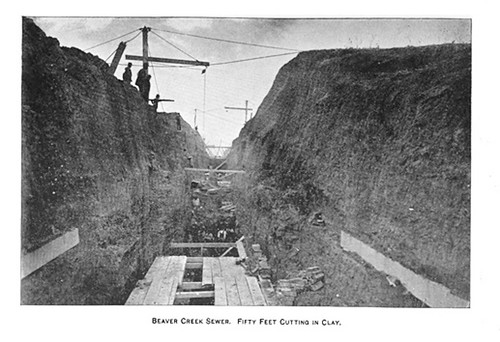
Construction of the Beaver Creek sewer in the late 19th century. / from the AlbanyGroup Archive on Flickr
As it happens, the sites of this flooding in recent years are along branches of the underground storm sewer that's essentially taken the place of the old Beaver Kill/Beaver Creek. (This presentation from a community meeting a few years back is a quick overview of some of this history.)
Today the Beaver Creek sewer drains a large area at the heart of Albany, about 25 percent of all the storm water in the city.
So, what's the project?
The Albany water department has a few things in the works:
Woodlawn Park
A large construction project in Woodlawn Park -- the area that got flooded with four feet of water in 2014 -- is building two structures designed to ease the strain on the sewer system during large rainfall events:

+ An infiltration gallery: That's the technical term for a series of large pipes that will be placed under the outfield of the baseball diamond there. They'll be able to hold about 750,000 gallons of water that will either slowly seep into the ground water or be allowed to empty into the sewer at a later time when there's capacity available. The water department will use underground sensors to monitor the capacity of the storm sewer and it'll be able to discharge the water based on the situation.
+ A new wetland: A pond/wetland area is being built just to the north of the baseball field that will be able to hold 500,000 gallons of water. Again, the idea is the same -- to hold onto the water until the sewer once again has the capacity to handle it.
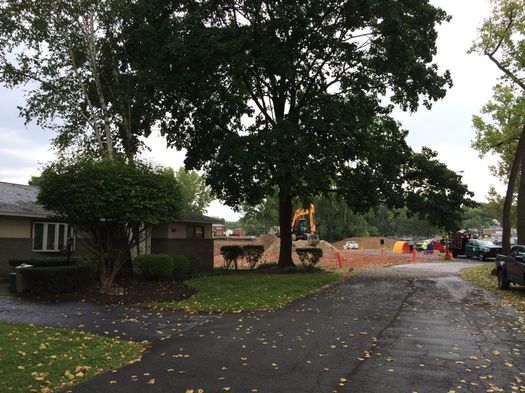
As Coffey said Wednesday, "This is a big scale project." And it's the the first such system in the city. Planning for it grew out of a series of community meetings that followed the 2014 flooding in the neighborhood.
The goal is to have the project finished in November.
Elberon Place/Washington Park Lake
You know that giant sinkhole that opened on South Lake? Well, the fix for that is still ongoing in part because the water department took the opportunity when everything was torn up to start upgrading 80 feet of large storm sewer there, a project that was already planned. Coffey said they hoped to have the new section installed this week.
The new sewer is part of a plan to direct separated storm water (that is, it doesn't have sewage in it) both from Elberon and Quail Street (where the city recently installed permeable pavement that allows storm water to sink through it) and direct it into Washington Park Lake. The water department will be able to manage the level of the lake so that it can use the body of water as another buffer for the sewer system, reducing the strain on the system during large rainfall events.
If these projects work out as planned, they should help reduce flooding and cut down on the amount of sewage that ends up in the Hudson by blunting the surges of the water through the sewer system.
Much of the money for the project is coming from the state, primarily the Department of Environmental Conservation. The city got $1.8 million as part of a competitive grant program.
Hi there. Comments have been closed for this item. Still have something to say? Contact us.
Comments
Recreating wetlands is the way to go. Albany needs to work toward daylighting the submerged creeks and restore the natural floodplain.
... said ace on Sep 16, 2016 at 9:07 AM | link
Thanks so much for putting this information out there! I know CSO discussions aren't sexy, but it's IMPORTANT. As an engineer working closely with many of these municipalities on stormwater and CSO projects, I know that green infrastructure is a term that will become more and more common in the coming years as we work toward reducing combined sewer overflow events and attempting to correct the issues created by loss of green spaces, etc (which is a huge contributor). Hoping we keep seeing content such as this, educating the public and building relationships with those in the Municipalities who are behind the scenes trying to get these important projects done - both small and large. Kudos!
... said Nadine Medina on Sep 16, 2016 at 11:25 AM | link
Can anyone answer a question I've had for a long time?
Doesn't the problem become worse every time a new a building is added on to the Albany sewer line?
It seems to me that every time an apartment complex or college dorm is added to the system the back ups become worse.
... said Joe Albany on Sep 16, 2016 at 12:26 PM | link
Do wetlands spread?
When they fixed the sewer situation at one end of our street, the other end started flooding. If they build a wetland, will the land around it also become marsh?
... said Melissa on Sep 16, 2016 at 2:13 PM | link
Wow... hats off to AOA. This article is thoroughly researched and well written. You guys do one hell of a job.
... said JB on Sep 16, 2016 at 2:46 PM | link
I agree with Joe. I fear that the new apartments on Allen. St as well as all of the development related to the University and Nanoland have complicated our situation. There were attempts to fix this after the 2008 flood, and 2014. This is a giant plan. I certainly hope it does the job, but I am skeptical.
We need more trees, fewer parking lots and fewer buildings where once there were green spaces.
... said Marggie on Sep 16, 2016 at 9:10 PM | link
Good discussion of this serious and chronic infrastructure problem and the work underway by the City of Albany to address it in conjunction with the Albany Pool Communities and their long term plan.
And, Joe, all new develpment in the City of Albany is carefully evaluated as to the impact on the storm water/sewer infrastructure and required to develop offsets.
... said CF on Sep 17, 2016 at 9:25 AM | link
Not only are new developments vetted for their impact on existing infrastructure, but we need far *more* buildings in this city. There is an abundance of empty space that can be (and should be) filled in with new development. Fortunately, we're starting to see this in areas like that around the Palace Theater.
... said JayK on Sep 19, 2016 at 11:46 AM | link
There were some issues with the construction: The work site was not signed in any way. It was unclear to neighbors what was being built there. There was no maintenance or protection of traffic (MPT) at all during construction. Cars would proceed down Woodlawn Ave only to find out it was blocked by a large excavator and a dump-truck with no flagger, no MPT, and no signs.
As for the work itself, it is primarily a holding tank- it provides extra capacity-but no extra "processing." It should help in large storm events, but it is not the answer. I am also concerned over potential odors emanating from 750,000 gallons of stored storm water and sediment under a baseball and basketball field but I trust that the community was consulted, environmental justice issues addressed, and that appropriate environmental impact statements were completed.
The answer is much more difficult and expensive. It answer lies in replacing combined sewer overflows separating the relatively clean stormwater from sewage. Until the city undertakes that work, we will continue to have very foul odors in storm drains, and we will continue to have periodic raw sewage discharges into the Hudson River.
... said MdP on Dec 2, 2016 at 1:30 PM | link